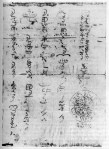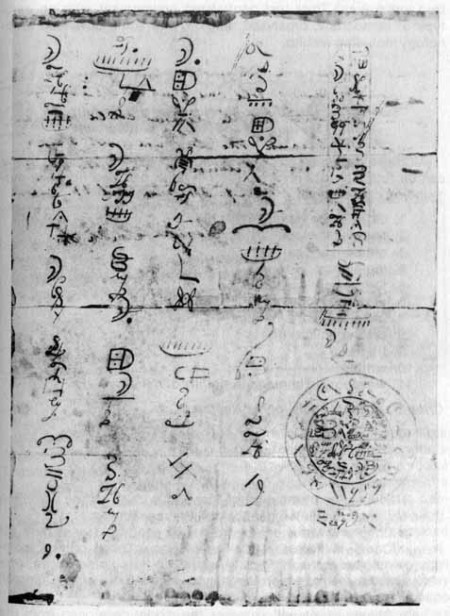 The Book of Mormon is a sacred text of the churches of the Latter Day Saint movement. It was first published in 1830 by Joseph Smith, Jr. as The Book of Mormon: An Account Written by the Hand of Mormon upon Plates Taken from the Plates of Nephi. According to Smith, the book was originally written in otherwise unknown characters referred to as “reformed Egyptian” on golden plates that he discovered in 1823 and then translated. The plates, Smith said, had been buried in a hill near his home in Manchester, New York, where he found them by the guidance of an angel, a resurrected ancient American prophet-historian named Moroni.
The Book of Mormon is a sacred text of the churches of the Latter Day Saint movement. It was first published in 1830 by Joseph Smith, Jr. as The Book of Mormon: An Account Written by the Hand of Mormon upon Plates Taken from the Plates of Nephi. According to Smith, the book was originally written in otherwise unknown characters referred to as “reformed Egyptian” on golden plates that he discovered in 1823 and then translated. The plates, Smith said, had been buried in a hill near his home in Manchester, New York, where he found them by the guidance of an angel, a resurrected ancient American prophet-historian named Moroni.
According to the Book of Mormon, that scripture of the Latter Day Saint movement was originally written by prophets living in the Western Hemisphere between 600 BC and AD 421. Joseph Smith, Jr., the founder of the movement, published the Book of Mormon in 1830 as a translation of these plates. Scholarly reference works on languages do not, however, acknowledge the existence of either a “reformed Egyptian” language or “reformed Egyptian” orthography as it has been described in Mormon belief. No archaeological, linguistic, or other evidence of the use of Egyptian writing in ancient America has been discovered. Although accounts of the process differ, Smith is said to have translated the reformed Egyptian characters engraved on golden plates into English. When Smith finished the translation, he said that he returned the plates to the angel Moroni, and therefore they are – of course – unavailable for study.

In 1828 Martin Harris, a farmer from Palmyra, New York received from Joseph Smith a copy of some of the “reformed Egyptian” characters from the gold plates in order to obtain scholarly opinion about their authenticity. Harris then presented the material to at least three scholars in the eastern United States, the most important being Charles Anthon, a noted classicist at Columbia College. In 1887, David Whitmer said that he had the piece of paper that Harris had showed to Anthon and the other scholars. This short document is known as the Caractors document or the Anthon Transcript.
So far Wikipedia. If you’d be further interested in the cryptography of the Anthon Transcript, I suggest you read this post on the fascinating Cipher Mysteries blog. For readers that can fill in the gap, I might just quote the author’s summary:
In summary, probably the least controversial inference you can draw from the lettershapes is their post-1650 dating: the embellished “H” shape and the probable links with Rich-family shorthand letter-shapes indicate that this is in no way ancient. In the absence of any other credible information, the most likely story I can reconstruct is that the “caractors” in the Anthon Transcript were copied in no particular order from a shorthand Bible (or possibly a shorthand diary), with various other letter-shapes added to make the overall alphabet look more ‘exotic’, or even ”hieroglyphic” (even though, to our modern eyes, these singularly fail to have the desired effect). I would also be fairly unsurprised if the same shorthand Bible itself was subsequently used as a prop to convince skeptics – in short, that this was the Detroit Manuscript itself (but which, like the rest of the Anthon Transcript, subsequently disappeared from sight).
Sources
http://en.wikipedia.org/wiki/Reformed_Egyptian

Tags: Charles Anthon, Cipher Mysteries, Joseph Smith, Jr., Plates of Nephi, reformed Egyptian, the Anthon Transcript, The Book of Mormon, the Caractors document, the Latter Day Saint movement
June 14, 2009 at 7:44 pm |
You should consider these articles written by LDS scholars on this topic:
http://mi.byu.edu/display/topical.php?cat_id=339
August 22, 2009 at 5:13 am |
Grim shows two images of an admitted hoax perpetuated by Mark Hofmann ca 1980. These should be deleted, for Hofmann was a proven forgerer. Grim also shows a copy of the genuine ‘Anthon Transcript’. Refer to my Geocities.com/bbbinil/ website for more information.
There are only 20 different elements which are combined in multiple ways. These 20 characters have been demonstrated to be modifications of Egyptian hieroglyphics, conveying meanings rather than representing sounds.
They were not copied from any shorthand system. I have found multiple chiasms in the document, so they are NOT random in order. The translation (see web site) yields a meaningful message from these chiasms.
This short document takes a full page of small print for the English translation!
Blair Bryant